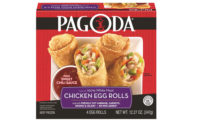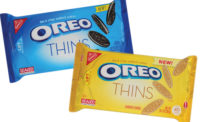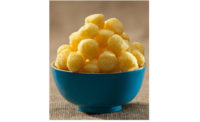The cracker market, like many other snack segments, is in an evolutionary state. If you ask Craig Lieberman, president and founder of Denver-based 34 Degrees, changes in the category span “from the types and styles of crackers to the location and placement of crackers in the store.” At retail, says Lieberman, specialty crackers that were once merchandised alongside potato chips and other snacks are now featured in the deli department, “where they are complemented by artisan cheeses, cured meats, and unique spreads, which sets the stage for consumers to become inspired and discover new entertaining and recipe ideas.”
Overview | Chips | Puffed/Extruded Snacks | Popcorn | Snack Mixes & Nuts | Tortilla Chips | Pretzels | Frozen Snacks | Crackers
On the product development side, manufacturers are shifting to accommodate consumers’ new flavor and usage demands. “The market for crackers comprises two distinct segments,” says Mark Beaver, director of sales at Baker Perkins Inc., Grand Rapids, MI. “Traditional hand-held crackers are mostly eaten at home with other foods such as cheese, dips, or deli meats, and the market for these remains strong. Meanwhile, demand for bite-sized snack crackers is growing. These are consumed on their own, both inside and outside the home as a snack, as part of a meal or even as a meal replacement.”
Market data
On the whole, IRI, Chicago, pegs the crackers market as reaching $7.4 billion in sales during the 52 weeks ending April 17, 2016, representing a 1.15 percent rise over the previous year. Crackers with fillings rose about 2 percent to reach just over $1 billion of the market share, with good growth coming out of offerings from PepsiCo, up 12.03 percent in dollar sales. WhiteWave Foods Company saw strong growth, up 93.53 percent in dollar sales. The company recently added organic cheese and peanut butter sandwich crackers to its Horizon brand.
The Hershey Co. recently added a Snacksters product under its Reese’s brand, with graham cracker dippers accompanied by peanut butter chocolate spread for dipping. The brand grew by 506.59 percent for the year to $9.3 million.
Snyder’s-Lance offers several crackers with fillings, and the company grew by 8.69 percent in dollar sales for the 52-week period. Its Lance Toasty products were up 17.90 percent, while Lance Toast Chee crackers rose by 10.42 percent. The company recently branched into gluten-free territory in the segment, launching Lance Gluten-Free Sandwich Crackers in cheese and peanut butter varieties.
In the all other crackers segment, Blue Diamond was up 8.54 percent in dollar sales, with its gluten-free Nut Thins increasing by 2.03 percent. Mondelēz International leads the segment with $1.6 billion in sales. Its Nabisco Ritz Toasted line was up 15.99 percent, while Nabisco Ritz Fresh Stacks grew by 23.57 percent. Mondelēz also continues to gain strength from upscale and diversified flavor profiles in its Nabisco Triscuit brand, which was up 8.21 in dollar sales to $348.5 million. Flavors like Balsamic Vinegar & Basil; Rosemary & Olive Oil; Dill, Sea Salt & Olive Oil; Roasted Garlic; and Fire-Roasted Tomato & Olive Oil complement its original Triscuit crackers.
Crackers continue to gain traction by blurring the lines between a cracker and a chip. The iconic Kellogg Co. Sunshine Cheez-It brand has added Grooves to its lineup, products that combine the “taste of Cheez-It Original Crackers and the thin and crispiness of a chip.” The Grooves line was up 24.92 percent in dollar sales for the year, per IRI, to $81.0 million. Cheez-It crackers lead the all other crackers segment by a wide margin, with regular Cheez-It products up 8.30 percent in dollar sales to $760.1 million.
Looking back
Clean-label and better-for-you crackers continued to gain momentum over the past year. “Consumer taste and health preferences continue to make the state of the market for crackers fiercely competitive,” says Genelle Chetcuti, senior director of marketing, RW Garcia, San Jose, CA. “These health preferences include demanding transparency or knowing who the company is, what it stands for, and where its ingredients come from. Nutrition-seeking consumers are health- and label-conscious, desiring clean, simple ingredient lists without additives, artificial flavorings or preservatives. Health-conscious and gluten-intolerant consumers are also driving continual gluten-free cracker sales growth.”
Chetcuti also sees demand for nutrient-dense ingredients driving innovation, such as those high in protein, fiber or omega-3 fatty acids. To that end, RW Garcia recently turned to “ancient grains, pulses, vegetables and a matrix of seeds such as chia, flax and black sesame to enhance both flavor and nutritional value,” Chetcuti says. The company’s latest launches include antioxidant-, fiber-, and protein-rich Sweet Potato, Sweet Beet and Kale crackers, which are all Non-GMO Project Verified and also certified gluten-free. The crackers’ primary base is non-GMO corn.
On the flavor side, cracker consumers are looking beyond the basics. “Specialty cracker companies are pushing the envelope on what a cracker can be, and consumers appreciate crackers with more-interesting flavors and ingredients,” explains Lieberman. “The flavor of the cracker is now being highlighted as a way to enhance the overall pairing and experience.” Specifically, he sees growth and innovation in the specialty deli cracker set, as artisan cheeses and charcuterie come to the forefront of consumers’ minds. These offerings can also present as “mini-meals,” he adds, which appeal to on-the-go eating trends.
34 Degrees leverages this association with its consumers by showcasing the versatility of its crackers online, educating around the importance of choosing the right cracker to complement—rather than compete with—the flavors of the toppings. “Through driving awareness and education on the importance of choosing the right cracker, we’re helping the specialty cracker category to be viewed as an essential culinary ingredient for any occasion or recipe,” Lieberman adds. The company is launching Chocolate and Vanilla Crisps in this category, which are “snackable on their own or paired with toppings both savory and sweet,” he says and “truly reinvent what a cracker can be” at just 60 calories per serving.
Looking forward
“Like other food categories, the latest trend in the snacks and cracker industry is clean-label,” says Joon Park, vice president of food ingredient sales, Rice Bran Technologies, Scottsdale, AZ. He defines clean-label as including simple, recognizable, wholesome ingredients while eliminating synthetic and artificial ingredients.
The company launched Proryza Gold in February 2016, which Park describes as “minimally processed, non-GMO, gluten-free, vegan, free from major allergens and nutritionally dense,” and would make sense in formulations needing a boost of protein and fiber. Derived from California-grown rice, the ingredient contains about 25 percent protein, 50 percent dietary fiber, as well as a vitamin B and E complex.
Looking ahead, says Lieberman, “an opportunity for growth in the category is for brands to recognize and respond to the shifting consumer patterns from the chip aisle to the store perimeter, like the deli, for lighter—yet still satisfying—snack options.”
Blurring the lines between the cracker segment and the greater snacks market is also on the radar for Beaver, who sees opportunities for ingredients like soy, whole grains and ancient grains to take hold in a range of shapes and textures in crackers, from stick and co-extruded to shredded and bite-sized offerings.
“We predict the consumer mindset shift toward simple, clean, non-GMO ingredients is here to stay,” says Chetcuti, adding that nutrient-dense vegetables and beans may strengthen future product offerings. “The continued growth opportunities in this space are infinite, but specialization and unique, flavor-forward options will continue to capture and retain adventurous consumers.”
Meeting the diverse desires of cracker consumers often leads snack producers to seek flexible equipment. Baker Perkins recently introduced two equipment developments for the cracker market. “One is producing snack crackers using extrusion sheeting technology,” he says. “This is a lower-output alternative to traditional cracker technology, and has the flexibility to make a wide range of other snack formats. The second is the introduction of upgraded sheet forming and cutting lines with improved sanitation and maintenance.”
For cracker producers, extrusion sheeting reduces both capital investment, as well as necessary floor space, says Beaver. “The lines are simple to operate and are also capable of producing a range of direct expanded and co-extruded snacks with rapid changes between them, which makes this an ideal way to enter the wider-range snack market.”
Overview | Chips | Puffed/Extruded Snacks | Popcorn | Snack Mixes & Nuts | Tortilla Chips | Pretzels | Frozen Snacks | Crackers









